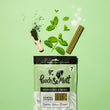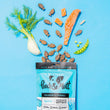
FREE UK DELIVERY ON ORDERS OVER £39.99
At this time of year, it’s important to pay closer attention to your pet’s paw pads. While they don’t usually require a lot of maintenance, some dogs require a little extra help when the weather gets cold.
As with people, some dogs find their exposed skin gets dry and cracked when exposed to cold weather and dry air. We may notice a cracked and flaky nose and paw pads. Certain breeds, such as the Staffordshire Bull Terrier and Siberian Husky are more prone to this happening.
For some, there may be an underlying medical issue. Things like hormone disorders, auto-immune disorders and nutritional deficiencies can all affect the health of the paw pads. So, if your dog suddenly develops an issue, a vet visit is sensible.
If your dog is struggling with their pads you may notice:
Dry and cold weather: While dogs have thick paw pads, they can’t always cope with prolonged cold weather. This is especially true of breeds who were bred in warmer climates. Walking on ice and snow can cause pads to quickly dry out.
Grit: Though gritting is important to prevent slippery surfaces and help snow and ice melt, it can be a real hazard to our pets. Grit can irritate their sensitive skin, especially if snow becomes impacted on top. The rock salt used can also be toxic to dogs if licked from paws.
Chemicals: While not associated with cold weather per se, it’s sensible to be on the lookout for chemicals on the ground where you walk. Bleach, chlorine and anti-freeze could all be hazardous to your dog if walked on.
Be sure your dog is being fed a complete and nutritious diet, such as one of Pooch & Mutt’s wet or dry foods. You may also wish to start a skin and coat supplement which can be given each day. Salmon oil is a great choice for soothing cracked paws and injecting a little extra moisture. On top of this, a food targeted at skin and coat health, such as the Pooch and Mutt Soft & Shiny kibble, is a good option for some.
Ingredients such as Biotin, Collagen and Omega 3 Fatty Acids are important for maintaining a healthy skin barrier and locking moisture inside the pads.
It can help to keep your dog’s paw fur trimmed and to ensure their claws are regularly cut. This will prevent grit and snow from clumping and makes for healthier paws all round.
Try to avoid visibly icy or snowy places to walk your dog, sticking to paths that have already been walked on. If your dog is prone to running about, keep them on the lead when the thermometer falls below zero.
Wipe paws down with a warm cloth after returning to the home on each occasion.
Outdoor booties are an option for some canine critters, though not all will tolerate them or enjoy wearing them.
Paw balms can be applied. Ensure these are dog specific products that won’t be toxic if licked off.
Whilst the colder months can be fun with your dog, especially when the snow starts to fall, just be mindful that you're wearing wellies and your pooch's paws are exposed to the elements, so do what you can to protect them and help them to stay healthy and happy through all weather.






Comments (0)
Leave a comment